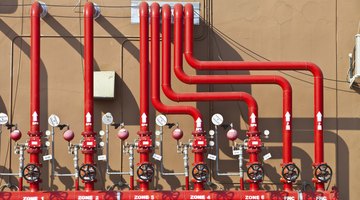The Differences Between Upright & Pendant Sprinklers
The basic difference between fire-preventive upright sprinklers and pendant sprinklers is the position each takes on a water pipe. An upright sprinkler, as its name implies, stands atop the pipeline, whereas a pendant type hangs from the pipe.

These two types of sprinklers, however, bear more slight differences than their opposing operating arrangement.
Configuration
Because of their particular configuration, upright and pendant sprinklers are classified as distribution sprinklers. Both use a design that allows them to spray water in a similar pattern from their respective positions. An upright sprinkler, however, comes with a water deflector at the top so that water coming out of the orifice shoots upward and then spreads in a circular pattern. Since a pendant type hangs from the pipeline, its water deflector is placed at the bottom, but water spreads in the same circular pattern as that of an upright sprinkler.
Visibility
Upright sprinklers, used mostly in warehouses or large structural buildings, do not hide behind the ceiling. Pendant sprinklers, used mostly in office or home buildings, may be visible or not. When concealed, pendant sprinklers hide under the ceiling under a special cap that falls away when the surrounding temperature rises to a prescribed level. If the temperature continues to rise, the concealed pendant head automatically drops and begins to spray water.
Effective Coverage
Upright sprinklers are used mostly in places where obstructions may block water spray during a fire, and their height allows them to aim water around possible obstacles. One downside is that the pipeline in an upright sprinkler can become an obstacle in itself to effective water flow coverage during operation. Pendant sprinklers are mostly used in office buildings where obstructions to water spray are minimal.
Velocity
Both upright and pendant sprinklers distribute water in a circular manner. This radial water flow pattern begins between the sprinkler orifice and the deflector in a pendant sprinkler, and between the orifice and somewhat slightly above the deflector in the upright type. This configuration tends to give pendant sprinklers a higher flow speed compared to uprights, although not significantly, according to a 2002 study published by the Building and Fire Research Laboratory of the National Institute of Standards and Technology. Modern upright model sprinklers have begun to address this issue to match rate response with that of pendant sprinklers.
The Drip Cap
- The basic difference between fire-preventive upright sprinklers and pendant sprinklers is the position each takes on a water pipe.
- Since a pendant type hangs from the pipeline, its water deflector is placed at the bottom, but water spreads in the same circular pattern as that of an upright sprinkler.
- Pendant sprinklers are mostly used in office buildings where obstructions to water spray are minimal.
- Both upright and pendant sprinklers distribute water in a circular manner.
References
Writer Bio
Since 2003 Dan Ferrell has contributed general and consumer-oriented news to television and the Web. His work has appeared in Texas, New Mexico and Miami and on various websites. Ferrell is a certified automation and control technician from the Advanced Technology Center in El Paso, Texas.
Photo Credits
- Aj_OP/iStock/Getty Images
- Aj_OP/iStock/Getty Images
More Articles



